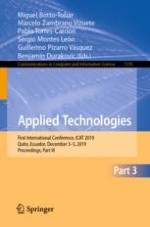2020 | Buch
Applied Technologies
First International Conference, ICAT 2019, Quito, Ecuador, December 3–5, 2019, Proceedings, Part III
herausgegeben von: Dr. Miguel Botto-Tobar, Prof. Marcelo Zambrano Vizuete, Pablo Torres-Carrión, Sergio Montes León, Guillermo Pizarro Vásquez, Benjamin Durakovic
Verlag: Springer International Publishing
Buchreihe : Communications in Computer and Information Science
